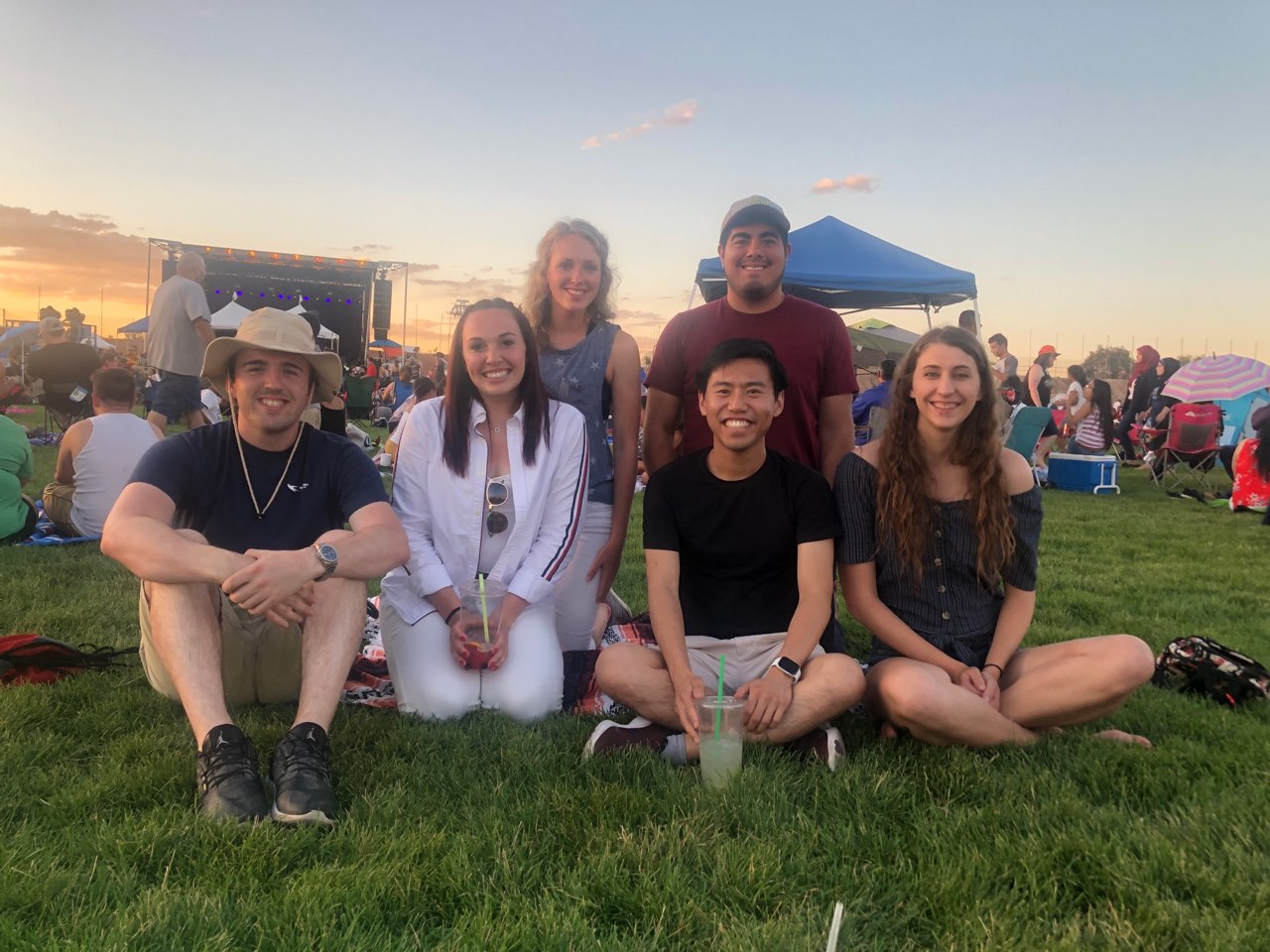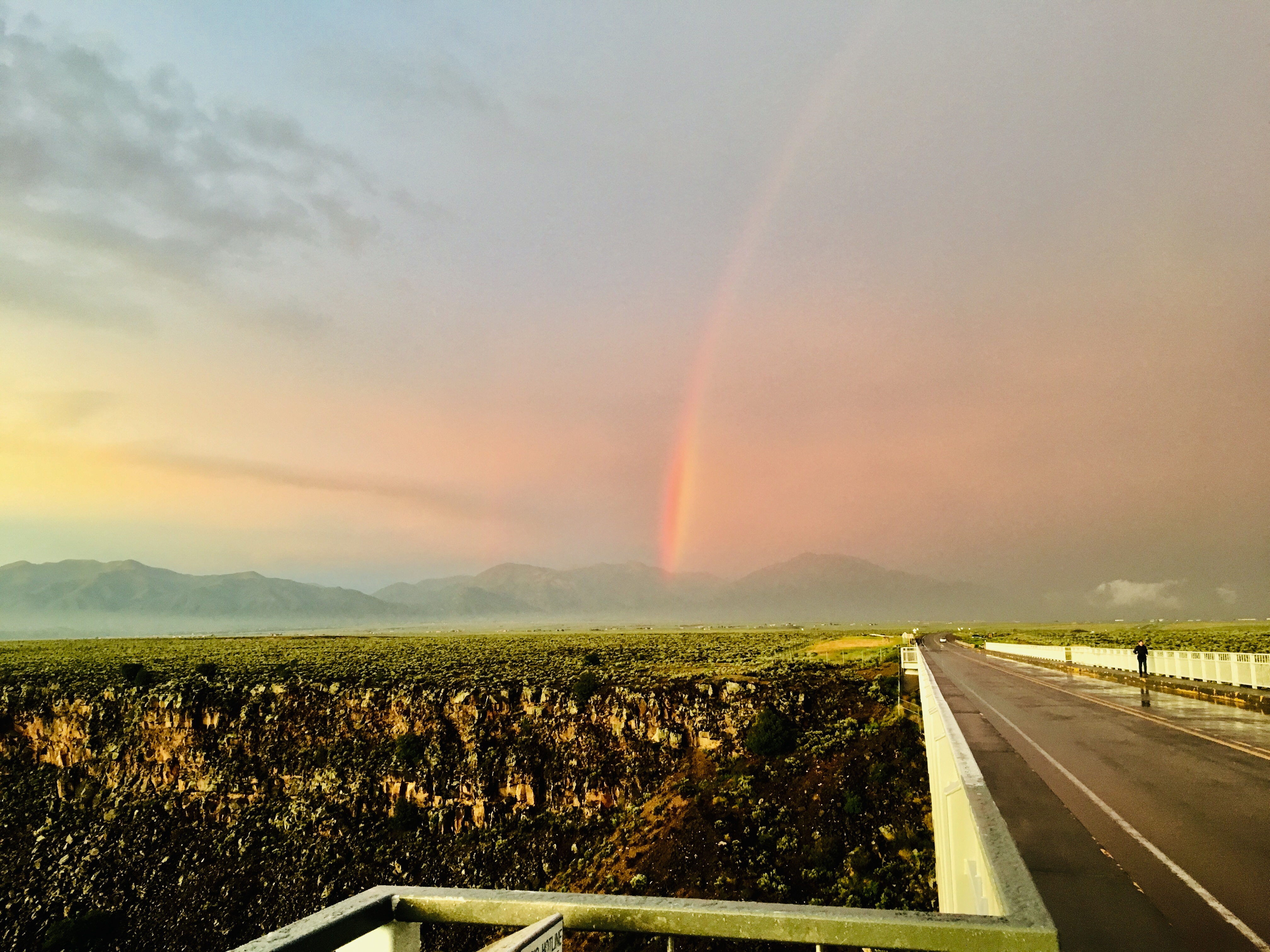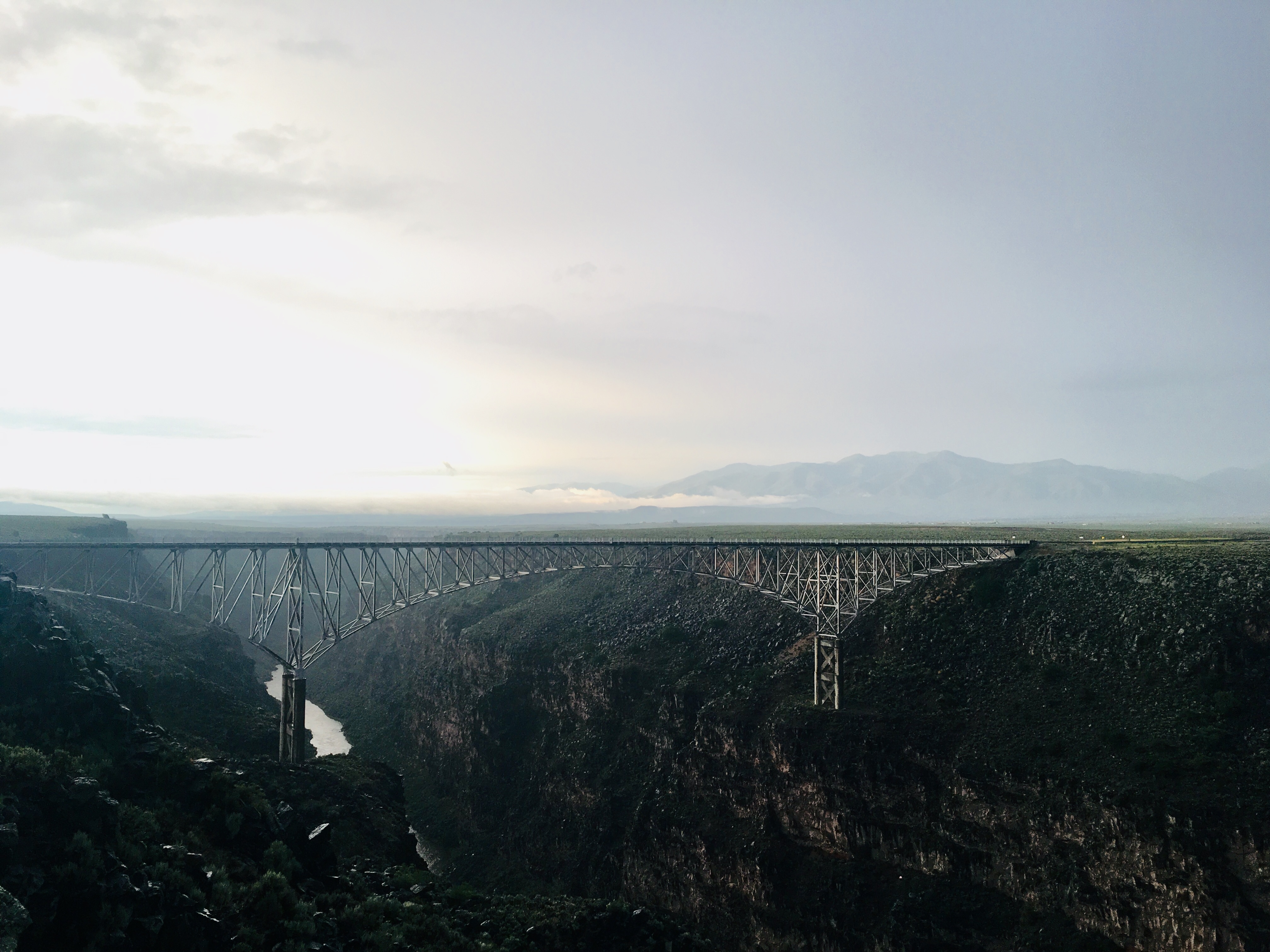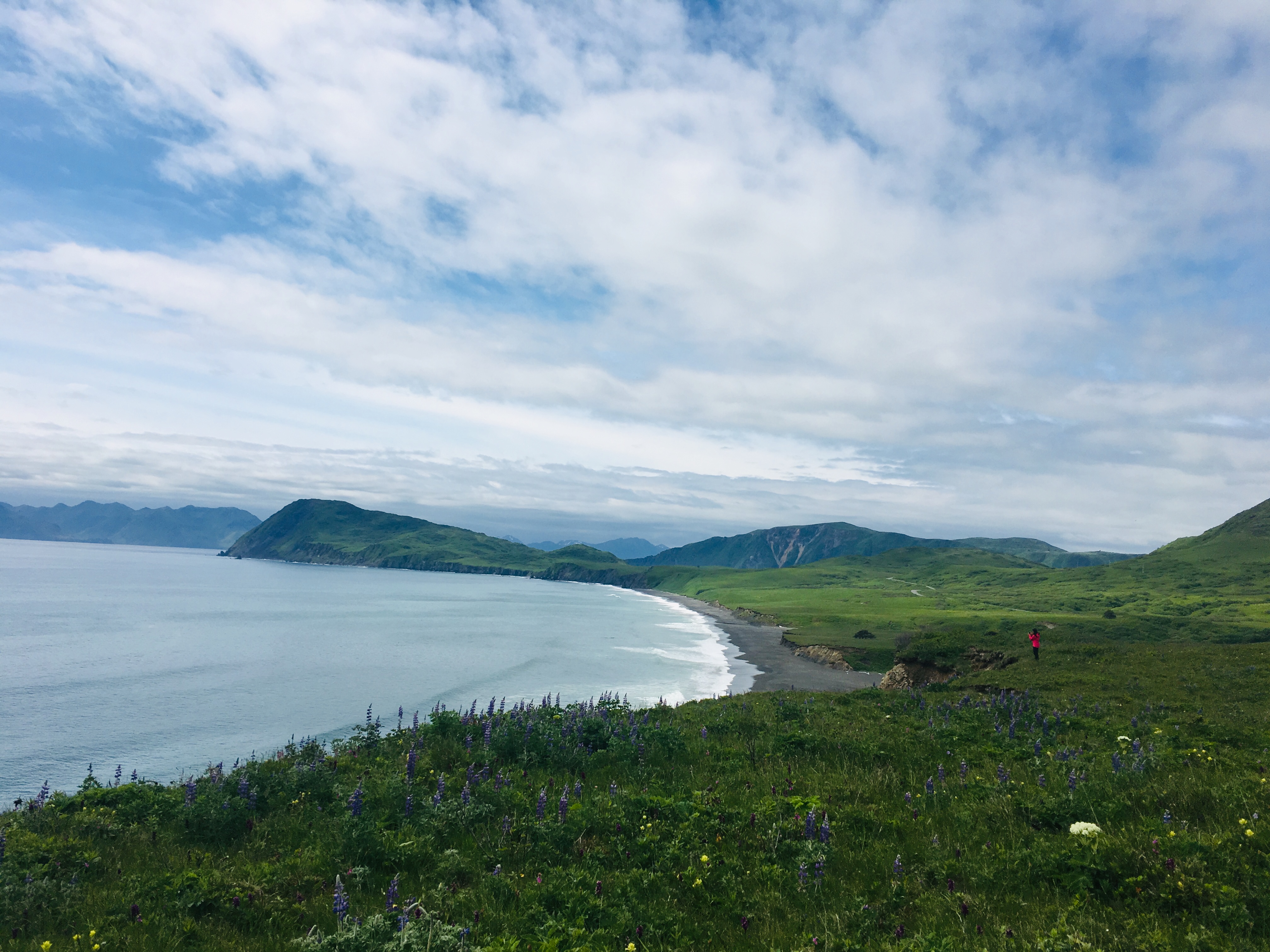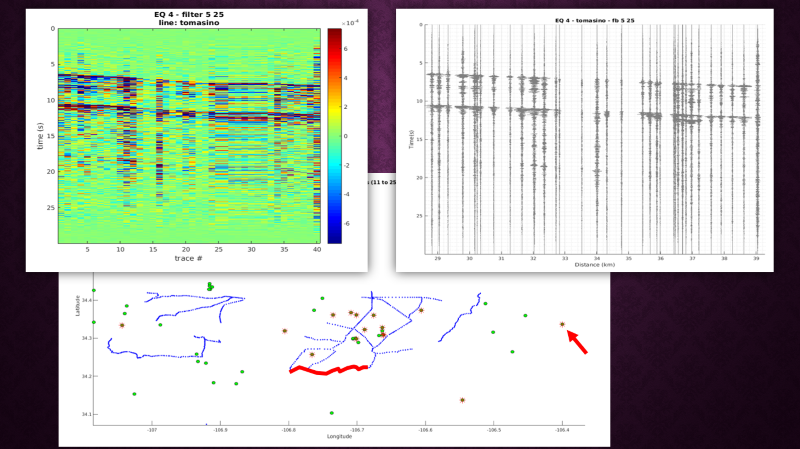Alysa
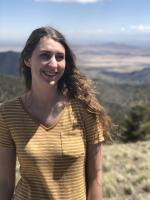
Alysa is a student at University of Arkansas currently completing her research at Universty of New Mexico under Dr. Lindsay Worthington.
This summer my main focus is on the Socorro Magma Body (SMB). The Socorro Magma Body is a mid-crustal magma body that is located in the Rio Grande Rift, NM and is estimated to be around 19km deep and have an area of about 3,400 square km. The thickness is estimated to be between 50-500m with an average of about 150m. The Socorro Seismic anomaly is contributed to the Socorro Magma body and around 23% of the earthquakes in New Mexico in the past 50 years have occurred in the Socorro Seismic Anomaly. The goal for this project is to use seismic data collected in 2015 from the area around the Socorro Magma body to determine and map the extent of the magma body. The data that will be used was collected from 801 vertical component seismic nodes and seven broadband stations that were deployed for a two week period.
Week 7/Week 9—Whoops!
July 30th, 2019
Wow time flies when you are down to the last few weeks and every day is crunch day! I thought I had posted for week 7 but here we are! I made multiple mental comments on everyone's blog posts but apparently didn't make any acutal comments, whoops! I suppose this is one challenge that I have faced this summer, balancing all the things I need to do! As I get closer to the end, I am definitely feeling the pressure and sometimes it is to the point where I have to stop everything and try to reorganize. This whole last week (week 8) was a big 'get my head on straight and focus' kind of week where I sorted what needed to be done when and planned on how I could go about starting it. Unfortunately I had came down with a pretty bad sinus infection on week 7 and did not take enough self care steps so I had a long recovery. Of course, this wasn't an academic challenge that I faced but it made focusing on my work very difficult most days and I admittedly did not make much progress on my work during that time but have since caught back up to where I wanted to be for my project as this point. Some of the biggest challenges that I faced this summer were knowing what steps to take next and understanding what exactly I was looking at. This often became an issue for me when someone would ask how certain things were calculated, since much of my work came from a script given to me I wasn't sure what the script was doing in the beginning. I have come to understand it much better now and know how the images I show people were created but it still is easier for me to show people the different files and scripts as I explain it because I still confuse myself--there's a lot of jargon I am still learning that simplifies my explanation if I could only remember it! The other challenge was knowing what steps I needed to take next and that was something I felt I could never get over, I was always asking "Okay what next? How would I go about setting that up?" Now at the end of this, I obviously know my next steps are my abstract and poster and confirming/finalizing my results but I also know the other next steps that I could do to improve my results if I had the time and makes me wish the summer would last a little longer!
Looking back at my goals for this summer, I feel pretty proud of myself for accomplishing them--even if it wasn't exactly in the timeframe I hoped.
1/3 Summer
- Find a favorite resturaunt (or two!)
- Feel comfortable using and modifying scripts in Matlab or asking for help when needed
- Have a comphresive knowledge of my study area and the previous research conducted
2/3 Summer
- Be able to confidently make decisions about how to move forward with the project
- Evaluate my understanding/interest and determine if seismology would be a future research interest or career path
- Have established valuable connections either with faculty or peers
3/3
- Construct and submit an AGU abstract
- Discuss/Consider continuing the project (if possible) into a senior thesis
- Feel accomplished in my work and confident in what steps I want to take next
I found a few restuarants I liked but I didn't try nearly as many as I hoped to, I ended up cooking a lot more than I thought I would! There is a very good burger place called The Burger Stand just down the road from the campus and I loved the BBQ chicken pizza that they served at the pizza place in the Union on campus. I frequented those places a lot this summer!
It was closer to halfway through the summer before I was really comfortable with the matlab scripts I was given. As I stated before, I wasn't entirely understanding what they were doing but by midway through I could modify them and understand what my changes were doing to my data. Either way, I asked for help a lot and everyone was always more than willing to give me a hand!
I read the few papers there are on my area multiple times over, and still skim them nearly everyday when I am referncing or modifying something with my data or models. It doesn't mean I don't learn something new about my study area nearly every day but I feel pretty well versed in what has previously been done and what I am doing now.
With just a week left, I am glad to say that I have accomplished the last three goals that I had set for this summer. I submitted my abstract about 20 minutes ago (and felt a huge weight come off my chest!). I have talked with my mentor and if I can arrange it back at my home institution, there is a very good possibility I could continue to work with her on this project while in school! As I was saying before, I know what steps I need to take next and I'm just sad that I am almost out of time but if it all works out then maybe I could continue my research--either way I feel very accomplished with what I have completed in this short span of time!
Week 5
July 8th, 2019
Week 5 has been my most eventful week so far! I celebrated the 4th with my roommates and some friends at the Balloon Fiesta Park. We saw a gorgeous sunset and then enjoyed some pretty awesome fireworks! We went to improv on Friday night and then had an impromptu Christmas in July celebration afterward and watched some christmas movies. Saturday was the best day despite it raining all day long--which none of us were expecting from New Mexico. We visited the Pueblos in Taos then walked around the Taos plaza for a few hours. We were soaked and ready to drive the three hours back but decided to stop by the Gorge bridge and hopefully be able to see well enough to get a picture. It ended up being the best decision of the day because it cleared up immediately and we saw a huge rainbow and an awesome sunset from the bridge!
During week 5 I was working on a few different goals and made progress in all of them but didn't necessarily finish any of them. Most of this included refining my map of my area which still needs work but after a few hours working with a grad student we decided we had done the best we could without our advisor so I set it aside for the week. I also started a very rough draft of my AGU abstract and plan to refine it some more this current week before I discuss it with my advisor next week. I have primarily been combing the reading for my AGU abstract and to confirm velocities for my area of interest. After gathering the most data I could about my area and creating a travel time curve I have spent most of my time comparing my plot to my best earthquakes. There were no depths or magnitudes given for my earthquakes and so I have been testing different depths and velocities on my travel time curve plot and comparing it to what I see with my earthquake data so I can try to constrain an approximate depth for my earthquakes. Once I have an approximate depth for my earthquake then I compare it to the predicted SzS reflection arrival and try to find the reflection in my data.
So while it is a simple image and calculation, this figure has been my primary focus for this short week: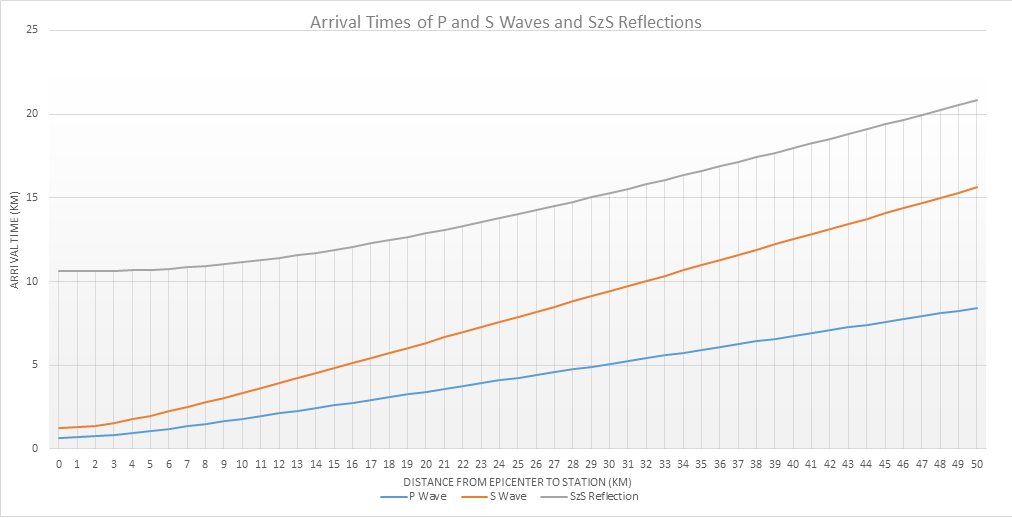
As I mentioned, a good portion of my week was going through my papers to pull out or double check the many variables and constants that I was using in my calculation. 'The 2015 Sevilleta Socorro Magma Body Mixed-Mode Seismic Experiment' paper has been the most important for gathering all of this data and helping me with background knowledge on my area for my AGU abstract. The paper discusses the types of instruments used to record the earthquakes, the duration and location of the deployment, estimated velocities for the SMB and crust, and has an example of an earthquake with a possible SzS reflection identified. This paper has helped me with each step of my research, from just understanding my area to calculating the travel time curve and picking out SzS reflections.
Week 3 and 4
June 30th, 2019
I returned from Alaska late Tuesday night this week and I have spent the rest of the week trying to lay out a plan for the last few weeks of my internship. My time in Kodiak, Alaska was amazing and I had so much fun working out in the field. I did not have a lot of time to draft or practice my elevator speech so I had to wait until I returned to Albuquerque and therefore I am a little behind on my blogs. Here is a picture from one of my last days on Kodiak when we went up Pillar Mountain!
As I started my elevator speech this week I quickly realized that I had been practicing it during my entire trip in Kodiak, Alaska. There were numerous people I met that were there to work on the AASCE project and I found myself trying to explain what my project was with Lindsay this summer. The first few explanations were wobbly at best and I was not confident in my description or knowledge of my project but by the end of the week I could give a quick 30 or 40 second overview of my work. I never went into the details about the programs I used or the specifics of the data I used so I knew that was something that I needed to add to my elevator speech. By the end of this week I felt that I had a good start to my speech but I found that there is a lot that I still don't really know of my project. I know what types of instruments were used to collect the data, the type of data I have, and where it is located but I have yet to really manipulate or understand what I am looking for in the data to accomplish my goal. A lot of this is because of the week and a half that I spent in Kodiak where I was not working on my specific project so while it has been four weeks I have only spent about a week and a half on my dataset. Lindsay and I have set specific plans for these next two weeks where I will really be manipulating the data so that I can hopefully see results and understand how to answer the questions set by my project goals. The elevator speech quickly made me realize that even if you feel like you do not know much about what you are talking about, explaining it to someone else will show you that your understanding is actually much deeper than you thought. I think having a prepared speech about any interest or project that you are working on is important even outside of AGU. Knowing how to express my interests and projects is going to be very important for interviews for jobs, internships, scholarships, and more.
As I was previously saying, one frustration that I faced this past week was realizing how little I felt I know about my project. The first two weeks I felt that all I did was run scripts and save images with very little modification or understanding of what I was looking for. I was beginning to feel overwehlmed as I realized I only have a couple of weeks left with my internship. When I returned from Alaska I talked with Lindsay about my hesitations, especially since she was leaving for two weeks for vacation so I about to be on my own. After setting some more specific goals and talking out what we are looking for, I feel better about what I need to do next. I am still concerned that I am not making as much progress as I should and over the next two weeks I would like to work faster and harder but I know that will be a challenge as I will be primarily on my own. I feel confident I can finish the goals set before the next two weeks are up but I am worried that I will still not know what steps to take next.
One success of this week was that while I only worked on Thursday and Friday, I spent most of it working on travel time plots for P and S waves based off velocities I found in literature. I compared these plots to my 'best' earthquakes and messed around with some variables until I found a decent model I could use to compare with the rest of the events I have saved. This allowed me to work on SzS arrival times to try and predict when we would see them on the images I have saved of my earthquake data. This next week I am excited to compare the times that I have calculated and see if I can identify any reflections in my various earthquake data/images. It would be a very big step toward reaching my end goal for the project.
Unforuntately I have not had the chance to make a better map of my area with my events and stations but that is one goal that Lindsay and I have set for this upcoming week. I will update this blog post once I have the map created with all my data included in it. I feel that simply looking at an image of part of the Rio Grande rift basin isn't all that interesting by itself.
Here's another picture of Alaska in the meantime,
Update! I had a few struggles with GMT regarding the topo grids I had access to. My area is relatively small and the topo grids I am using do not have great resolution at such a small scale. I know there is a grid that works well within my area bounds but I have to wait until next week before I can get access to it. For now I created a map using the USGS topo and illustrator to cobble something together!

Week 2
June 15th, 2019
I wanted to start this post by stating that I am currently sitting in the Seattle Airport on my way to Kodiak, Alaska where I will get to spend the next week and a half learning about Alaskan plate tectonics and retrieving seismic nodes! I am excited but also a little scatter brained because I have been up since 4 this morning and I still have seven more hours of traveling before I reach my destination.
The trip to Alaska does not necessarily relate to the project that I am working on this summer but the nodes that I will be retrieving are very similar to the ones that collected my data. The data set that I am working with was collected from 801 seismic nodes that were deployed in Socorro, New Mexico from the 11th to 25th of February, named the Socorro Seismic Array. My main focus of the project is the Socorro Magma Body (SMB) which is located in the Rio Grande Rift in Socorro Mexico. It is estimated to be about 1300km in area and about 19km deep. The thickness of the magma body is still mostly unknown with estimates from 100-300m thick. I will be using the data from these nodes to look at local earthquakes and try to map the extent of the Socorro magma body by identifying S wave reflections. There are some constraints on the data due to the type of node deployed and the location of the nodes. For this data set, only the vertical component was recorded on the seismic nodes. Only having the vertical component can make it difficult to correlate and confidently verify results and anaylsis. The location of these nodes was over a fairly widespread area but was confined to road access and so comparing traces is very easy in some sections where multiple nodes might overlap in distance from the earthquake but in other locations there may just be one node or a large gap between nodes. We also intend to look at some broadband station data that will provide the 3d component to the data and a little more range but there are only seven of these so this data will primarily be used to correlate and verify what we see on the other data.

Primarily for this week I continued to refine the images of my seismic traces for each earthquake and picked out the best ones (of 58 earthquakes). I then worked on looking at the seismic traces per node line instead of all the nodes at once. This allowed me to have a clearer image of the P and S wave arrivals and see how the waves traveled across the array. Most of this work was done the first two days of this week and the rest of the week I focused on creating wiggle traces for my best earthquakes. With both weeks so far I have been given a script that was practically complete and only required me to change some variables and load in the data. This worked well for me as I had no prior experience in Matlab and allowed me to learn how to work around some of it's nuisances. I have refined some of the first few scripts since I have recieved them and as I understood more about the data I was working with. At the beginning of this week Lindsay and I set some goals we hoped to accomplish by the end of the week. The first was to create trace images of the seismic data on a line by line basis instead of using all of the nodes at once. The second goal was to create wiggle trace plots of these earthquakes also on a line by line basis. The third was to start working in GMT to create a better quality plot of my earthquake locations and the seismic node instrument locations. I was able to complete the first goal fairly early in the week but unfortunately could not get the script working for the wiggle trace plot. I struggled with it for a day and went home feeling pretty frustrated because I had not made any progress. Thankfully the next morning I was finally able to produce some images...for a about half of my lines and earthquakes. It was also on this day that I met one of the grad students that had been gone all of last week. She told me if I ever needed help or if I got stuck to come find her. She jokingly told me that she expected me to talk to her before the end of the week or she'd be disappointed. I lasted about 30 minutes after that conversation before I went and asked for her help! We spent about two hours on the issue and finally resolved it then she helped me reorganize the data so I could be able to easily modify it later on. Unfortunately I spent most of my time working on the wiggle plots that there was not a good time to start working in GMT but that goal is not as important as the other two so I still felt pretty accomplished this week.
As for the mentoring rubric and skills worksheet, this week I feel that I really took some big steps in understanding and using Matlab. I was able to understand a lot more of it than I thought I would when Margaret was explaining the errors and her process to fixing them. I feel that I will feel proficient in this software and the other software I will be using once I can create my own scripts and debug my errors without a lot of extra help. I believe there will always be a point where I run into an unfamiliar problem and cannot find the solution but by that point I hope that I can still take charge in working it out instead of sitting back and having it explained to me. Once I can explain it to someone else and help them is when I will feel I am truly proficient in it. At the rate that I am going now, I hope to accomplish this by the end of the summer!
Week 1
June 10th, 2019
I began my internship on Monday, June 3rd, with a tour of the University of New Mexico campus. I also met with a few of the graduate students that will be working here over the summer and got to learn about the projects they were each working on. A lot of it was over my head but it was still very interesting to hear about and I hope by the end of the summer I will be able to truly understand their projects and the process they went through to get results. Everyone has been very nice and open about helping me out if I need anything this summer. I spent the first half of the week reading a few articles and reports about the Socorro Magma body and the previous research and data collection that has been conducted in the past few years.
I have quite a few goals for this summer that are a mix of personal and academic!
Personal goals include:
- Exploring Albuquerque and finding the best places to eat
- Visitng Santa Fe and checking out all the art galleries and museums I have been told about
- Hiking some of the trails around Sandia Mountain and visiting the top at least once for a sunset
The academic goals that I have include:
- Figure out geophysics i.e learn about the field of Seismology and ongoing research to see if it is something I might want to continue with later in my career
- Understand the project that I am working on, including but not limited to; learning how to use Matlab to create my own scripts, being able to recognize and filter what data might be useful, and knowing how to analyze and organize the data so that I can reach a conclusion about what I have been working on
- Feel confident in my project and be able to discuss it with peers and others in the scientific community
Throughout the summer I plan to accomplish all of these goals within these deadlines
1/3 Summer
- Find a favorite resturaunt (or two!)
- Feel comfortable using and modifying scripts in Matlab or asking for help when needed
- Have a comphresive knowledge of my study area and the previous research conducted
2/3 Summer
- Be able to confidently make decisions about how to move forward with the project
- Evaluate my understanding/interest and determine if seismology would be a future research interest or career path
- Have established valuable connections either with faculty or peers
3/3
- Construct and submit an AGU abstract
- Discuss/Consider continuing the project (if possible) into a senior thesis
- Feel accomplished in my work and confident in what steps I want to take next
I feel that I am well on my way to accomplishing the first few goals for the summer! After spending this first week learning the ropes of Matlab--specifically after spending hours on a problem just to later realize there was a much simpler solution than I was attempting--and learning about my area of interest, I feel much more confident going forward with this project. My mentor and I have set goals for this next week and I am excited to get started! I also leave for Alaska at the end of the week so I know time will fly by very fast and I just hope I can keep up!



